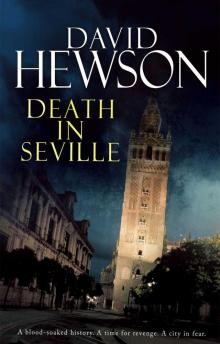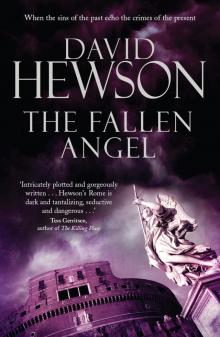- Home
- David Hewson
The Seventh Sacrament Page 5
The Seventh Sacrament Read online
Page 5
Games.
There were so many games. Theirs was an entire relationship based on play, because when Giorgio wasn’t engaged in some obscure diversion he was somewhere else, inside a book, head bent deep over a computer, always avoiding what Alessio’s mother called “the real world.” Games connected them. Hide-and-seek. Show-and-tell. Games that collided with the past sometimes, and the stories he told too.
Theseus and the Minotaur.
That was one of his favourites. A brave lost warrior, a stranger in a strange land, meets a beautiful princess and, in order to win her, must accept a challenge. A monster lurks in a lair, a hidden labyrinth of corridors beneath the ground. Half man, half bull, a dreadful, unnatural being that devours young men and women—seven of each, which, Alessio thought, was one reason he remembered so clearly—as a tribute.
Theseus offers himself as a sacrament, enters the labyrinth, finds the monster and—this was very clear in his memory too—beats the creature to death. Not a clean end, cut in two by a sword, but with some crude bloody club, because this was a beast, not a man, and a beast deserved no better.
Or a half beast, half man. To Theseus there wasn’t much difference.
The princess, Ariadne, helped Theseus with a gift: a ball of string which he unwound as he entered the caves, and then used to find his way back home to safety, with those he had rescued.
Alessio sat calmly at the table in the bright, bright cave, remembering all this, wondering what it meant. Giorgio had retold this story only a few days before. Alessio knew that his father was a man who rarely wasted anything—breath, a sentence, the simplest of physical acts. Was that conversation, then, significant in some way?
Mithras, the god his father knew so well, had killed a monster too. One that was all beast. Alessio had looked in Giorgio’s desk once and seen a photograph there, lurking like a secret waiting to be found. The bold, strong god, straddling the terrified animal, gripping its head, thrusting a sword into its neck. Mithras hadn’t resorted to a club for this killing. But this was all beast, so perhaps that was different.
One more memory. In the picture, beneath the animal, there were creatures, strange and familiar, doing things he didn’t quite understand. The scorpion in particular, which wielded its pincer claws at those parts of the animal small children weren’t supposed to see, least of all mention.
“A game,” Alessio repeated quietly to himself. In the end, everything came down to this, whether it was seeking a monster in a cave to prove oneself worthy of respect, or peering through the keyhole of an order of ancient knights, looking for a familiar shape across the river, one whose presence would keep in balance the myriad worlds he saw through those stupid glasses.
A game was what Giorgio wanted. That was why they had come here in the first place. It was a challenge. Perhaps the challenge, one so large, so daunting, so difficult, like the Minotaur pitched against Theseus, that it would be his making. Giorgio Bramante was waiting for his son to understand, to rise and accept his fate, to find the courage to walk into the darkness and track down where he was lurking. After which…?
It came to him, instantly. This was the first sacrament, the striking of fear in the beginner. Afterwards he would become Corax to Giorgio’s Pater, part of the greater secret. The elusive relationship of family, the eternal trinity, father, mother, and child, would be strengthened and one day made perfect by these changes. It would endure forever, never doubted, even in those dark moments when he heard the two of them, Giorgio and her, screaming at each other, full of drink and fury, bellowing words he didn’t quite understand.
Alessio Bramante looked around the room and laughed. Dark doorways didn’t scare him, nor the sounds he thought he continued to hear echoing from some distant, hidden location.
He got up and walked past each of the seven exits, thinking, looking, listening. He imagined that somewhere in the unseen distance he could discern his father’s voice, teasing in the dark.
Games involved two people. Both had to play.
He returned to the table and picked up the large flashlight his father had left there, deliberately, he now knew. It was big, almost half the length of Alessio’s arm, encased in hard rubber, and a long yellow beam spilled from it when he turned it on.
The light painted the shape of a full moon on the wall nearest the entrance, which was now almost completely in shadow, barely illuminated by the single bulb he’d left on. Alessio placed two fingers in front of the lens and made an animal shape. A beast with horns. Theseus’s Minotaur. The bull that Mithras sought.
There was a pile of tools near the exit he’d chosen. Pickaxes and shovels, iron spikes for marking things, spirit levels. And a large ball of twine, held at one end with what looked like a long knitting needle.
Alessio put down the flashlight and retrieved the twine, unpicking the iron object from the end. He tied the open loop of string to his belt and tugged. It came away easily and left a fresh end of the thread dangling in his hand. Alessio looked at the string again. Someone had tried to cut it once before, weakening it at the point before the loop. Quickly, he tied a second loop through his belt, tugged on that, made sure it was firm, then dropped the ball on the floor.
Then he retrieved the flashlight and turned to face the long corridor, wondering what, if anything, he—or Giorgio—would dare tell his mother when they finally came home.
Nothing, he decided. These were secrets, never to be repeated. This was part of the great adventure, the journey from boy to man, from ignorance to knowledge. He walked forward, feeling the tickle of the unwinding string fall against his legs like the desiccated wings of some dying insect, tumbling down to the ancient dust at his feet.
PINO GABRIELLI WASN’T SURE HE BELIEVED IN PURGATORY but at least he knew where it was meant to be. Somewhere between Heaven and Hell, a middle place for tortured souls lurking, waiting for someone living, someone they probably knew, to perform the appropriate feat, flick the right switch, to send them on their way. And somewhere else, too, much closer. On the wall of a side room in his beloved Sacro Cuore del Suffragio, the white neo-Gothic church that had become Gabrielli’s principal pastime since he retired from the architecture department of La Sapienza university almost a decade before.
Not that it was much of a secret anymore. On that chill February morning, with wisps of mist hanging in the icy air over the Tiber, Pino Gabrielli saw there was a visitor already, at 7:20 a.m., ten minutes before he opened the church doors. A man was standing in the doorway beneath the small rose window, stamping his feet against the cold. As Gabrielli cast one last glance at the river, where a lone cormorant skimmed lazily in and out of the grey haze, he wondered what brought someone there at that early hour, a middle-aged nondescript type, not the usual young sensation-seeker by the look of things, though it was difficult to tell since the man was wrapped up tight in a heavy black jacket, with a woollen hat pulled low over his ears.
Gabrielli dodged through the heavy slew of rush-hour traffic, marched up to the church, put on his best welcome smile, and threw a rapid “Buon giorno” in the direction of his visitor. Something got muttered in return; the man sounded Italian at least, though the words came through a thick scarf pulled high up to his nose. Perhaps that explained the early start, and the sensitivity to the cold.
Then, straightaway, the visitor asked the usual question—Is it still there?—and Gabrielli’s spirits fell. In spite of appearances, the man was just another rubbernecker looking for something, anything, to chill the spine.
The warden suppressed a grumble, took out the old key that opened the main door, let the man in, and pointed the way through the nave, half lit by the persistent morning light. He watched him go, then went to his small office, warmed his fingers around a paper cup of cappuccino, and devoured a single cornetto, filled with jam, feeling a little uneasy. He was used to a good hour on his own before anyone came, a time for reading and thinking, wandering around a church he’d come to regard as his own small universe.
/>
Gabrielli picked up a pamphlet and wondered whether to go and offer it to the visitor. The documents were a good twenty years old now and a little musty-smelling from the damp cupboard in the office. When he held one out, people always shook their heads and said no. But it wasn’t the money he wanted. Gabrielli was happy to give them away for free. He’d just feel happier if more people appreciated the church in his charge for what it was, instead of rushing off to see a display that was mostly, he guessed, old junk.
In a city overloaded with the baroque and the classical, Sacro Cuore was a small, bright, sharp-featured beacon of northern neo-Gothic. The church was barely noticed by the masses as they cursed and sighed their way past it in the traffic crawl along the busy riverside road running west from the Castel Sant’Angelo. But Gabrielli knew every inch of the building, every ornate pillar and column, every last curve of the elegant vaulted ceiling, and understood, as both an architect and a lay, semi-enthusiastic churchman, how precious it was.
Those who could speak Italian might read in the guide how a Bolognese architect, Giuseppe Gualandi, had constructed a perfect pocket-size Gothic cathedral on the orders of a French priest keen on giving Rome a Chartres in miniature, though with rather less-expensive stained glass, and in a decidedly urban location. How, too, that same French priest, inspired by a strange incident in the church itself, had set up a small exhibition, just two glass cases on the wall, one large, one small, stocked with a modest collection of exhibits.
For some reason—Gabrielli didn’t know and didn’t much care—this small exhibition had come to be known as Il Piccolo Museo del Purgatorio, The Little Museum of Purgatory. It had existed in the side room, largely unvisited, for decades. But in the modern age, more and more sought targets beyond the customary sights of the Colosseum and St. Peter’s. At some unforeseen point along the years, Sacro Cuore had emerged from dusty obscurity and made its way onto the lists of arcane Roman spectacles exchanged among the knowing. And so Gabrielli’s four days a week as voluntary guardian of Sacro Cuore, once a time for meditation and solitary exploration of the dark corners of Gualandi’s creation, had altered. Now a steady trickle of visitors arrived in ever greater numbers with each passing year, as the curious, mostly young, mostly agnostic, came looking for a sight they hoped would send a shiver down the spine, make them believe, perhaps, that, in a world of pressing and trite routine, where everything was capable of explanation if one merely turned on a computer, something, some whispered cry from elsewhere, existed that said There is more, if you only knew.
Most of the thrill-seekers were disappointed. They thought Purgatory and Hell were synonymous and came expecting something out of Hieronymus Bosch: real demons, real pits, places to convince the sceptical that the Devil still roamed the earth attempting to find a crack, between the bus ride home and the TV, through which to work his way into the lives of the innocent. In truth, despite the rumors, there was nothing lurid to see at all in Sacro Cuore. Gabrielli, a man with a taste for foreign fiction, frequently tried to put it this way: the Little Museum was more M. R. James than Stephen King.
All he could show them—discreetly turning away in order to avoid witnessing their disappointment—was what had been here for decades, unchanged: two glass cases and the eleven small items they contained, mundane objects deemed to provide evidence that there were indeed souls in torment, elemental creatures who could, on occasion, penetrate the world of the living and pass along a message.
There was one more item. But, given the chance, Gabrielli always stood with his back to that. The small case at the end of the little room was easily overlooked. It contained the only exhibit of modern origin, a diminutive T-shirt, with the insignia of an elementary school on the chest. It was an unusual decoration for a child’s uniform, one that was beginning to fade now, after fourteen years on the wall, behind the glass of the cabinet, beneath the persistent glare of the fluorescent tubes. Still, it was easy to see what was once represented on the cheap, white cotton: a seven-pointed star outlined in black, set inside a dark blue circle containing curious red symbols in its border, with seven smaller dark stars set at equal points around the outer ring.
For a time Gabrielli had tried to decode this curious image, until something—a nagging sense of overzealous inquisitiveness, perhaps—stopped him. That and the sure knowledge that, whatever the symbol’s origin, it was most certainly not Christian, as befitted any modern school in Rome, even in a secular age.
The characters in the border of the circle were alchemical symbols for the months of the year. The outer stars represented, he had come to believe, the seven planets of the ancients: Mercury, Venus, Jupiter, Mars, Saturn, the Sun, and the Moon. The inner star was the Earth itself perhaps, although he was unable to find any firm reference material to support this idea, and the academic in him, though retired, found this hypothesis difficult. Whatever it represented, the symbol was pre-Christian. Gabrielli felt the inner star signified the soul, the essence of an individual’s being, trying to find its place among the eternal, celestial certainties.
But by the time he had begun poring over that possibility, he had come to realise the object in the case was becoming more than a little discomforting. Everything else here belonged to the long-dead. This, however, was recent. On a few occasions, he’d even met the boy it had belonged to, when his father had taken him into the nearby archaeology department in La Sapienza where he worked and let him roam around the offices, charming everyone he met. Alessio Bramante had been a beautiful child, slender and tall for his age, always curious, if a little shy around his father, a man who dominated even his more senior colleagues. Gabrielli found to his distress that he could still summon up the visual memory of the boy very easily. In his mind Alessio still stood there in his office, quite serious and composed, asking slow, intelligent questions about Gabrielli’s work. He had long shining black hair, lively brown eyes that were forever wide open, and his mother’s looks, a quiet, unhurried beauty of the kind that, centuries ago, had found its way into paintings when the artist sought a face that could silence the most troubled of watchers with a single, calming glance, one that said I know, but that is how things are.
This personal connection changed things, so much that, in the end, Gabrielli stayed away from the last exhibit as much as possible. It was unhealthy to become obsessed by the cast-off garment of Alessio Bramante, a dead schoolchild, victim of a tragedy no one could begin to comprehend. There were times he regretted his own personal involvement in having it placed in the Piccolo Museo in the first place.
And there was another cause for concern too, one that bothered him much more when he cared to think about it.
There was the blood.
EVERYTHING ELSE ON THE WALL of the small room in Sacro Cuore was static, frozen in time. Burns or fingerprints or mere accidental stains that only faded with the years, with nothing left to hint that living, breathing human beings had once touched them. Only one other object, the sleeve of the chemise of the Venerable Mother Isabella Fornari, abbess of the Poor Clares in Todi, possessed a bloodstain, now a pale, indistinct dun brown, and that supposedly belonged to the shade of a former Abbot who died in 1731.
Alessio’s T-shirt was of more recent origin. Beatrice Bramante said she had discovered it while searching her son’s room just after his disappearance. Over the lowermost star she found something inexplicable: a red mark, fresh and ragged at the edges, as if it had occurred only minutes before. Nothing could explain the stain’s presence. The garment had been newly washed shortly before the tragedy and left in a cupboard, untouched during the days of torment that had preceded its discovery.
The mother had approached Gabielli and asked if it would be appropriate for the item to be added to the collection of the Little Museum, contemporary proof that those departed in tragedy could still send a message to the living.
There had been doubts. Gabrielli believed the shirt should have been sent to the police. Others deemed that the plight of the boy’s
father now made that inappropriate. The priest at the time had little affection for the odd assortment of curios he had inherited. Yet even the priest relented when faced with Beatrice Bramante, a woman who was both distraught and utterly determined. Then there was the unavoidable truth: a bloodstain had appeared on a seven-year-old’s white T-shirt while it was folded, clean and neat, in a cupboard in his home. All at a time when the child was gone from sight, presumed, by everyone, to be dead.
So they had relented, and before long come to regret it. Three years after the T-shirt had gone on the wall of the Little Museum, it had acquired another bloodstain. Then, in subsequent years, two more. Each was sufficiently modest to prevent it attracting those unfamiliar with the object. The fact was acknowledged quietly by those more observant among the church hierarchy, the case withdrawn from view until the newest stain faded, losing its freshness, then returned to the wall. Its metamorphosis was never mentioned again, for fear of unwanted publicity.
Gabrielli, who had been a party to this subterfuge, always knew a reckoning would come. If one accepted the premise of Purgatory, it was clear what was happening. The stains were a message. They would continue until someone listened, someone saw fit to act. The rational part of his mind told him this was impossible, ludicrous. Wherever the ghost of the hapless Alessio—just repeating the name to himself brought back a memory of the boy, stiff and upright in his office, asking intelligent questions about Bernini and his legacy in Rome—had gone, it could not be capable of making its mark on a simple object in a glass case on the wall of a curious church by the side of the noisy and traffic-choked Lungotevere Prati. The mundane and the unworldly were not supposed to meet like this.

 The Garden of Angels
The Garden of Angels Solstice
Solstice Death in Seville
Death in Seville A Season for the Dead
A Season for the Dead The Killing tk-1
The Killing tk-1 The Savage Shore
The Savage Shore Dante's Numbers
Dante's Numbers Sacred Cut
Sacred Cut City of Fear nc-8
City of Fear nc-8 The Blue Demon
The Blue Demon The Garden of Evil
The Garden of Evil The Lizard's Bite
The Lizard's Bite The Wrong Girl
The Wrong Girl Sleep Baby Sleep
Sleep Baby Sleep Lucifer's Shadow
Lucifer's Shadow Season for the Dead
Season for the Dead The Seventh Sacrament
The Seventh Sacrament The Garden of Evil nc-6
The Garden of Evil nc-6 Juliet & Romeo
Juliet & Romeo A Season for the Dead nc-1
A Season for the Dead nc-1 The Fallen Angel nc-9
The Fallen Angel nc-9 Little Sister
Little Sister The Lizard's Bite nc-4
The Lizard's Bite nc-4 The Killing 2
The Killing 2 The Fallen Angel
The Fallen Angel The Sacred Cut
The Sacred Cut Carnival for the Dead
Carnival for the Dead The Villa of Mysteries nc-2
The Villa of Mysteries nc-2 Macbeth
Macbeth The Killing - 01 - The Killing
The Killing - 01 - The Killing The Villa of Mysteries
The Villa of Mysteries Dante's Numbers nc-7
Dante's Numbers nc-7 The Sacred Cut nc-3
The Sacred Cut nc-3 The Seventh Sacrament nc-5
The Seventh Sacrament nc-5